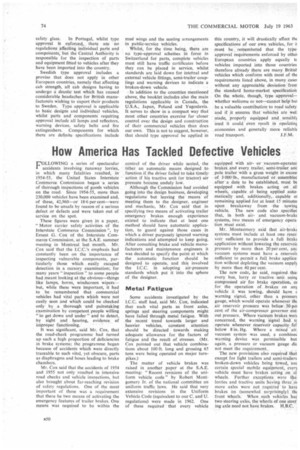How America Has Tackled Defective Vehicles
Page 76

If you've noticed an error in this article please click here to report it so we can fix it.
FOLLOWING a series of spectacular accidents involving runaway lorries, in which many fatalities resulted, in 1954-55, the United States Interstate Commerce Commission began a series of thorough inspections of goods vehicles on the road. Since 1954-55, more than 230,000 vehicles have been examined and, of these, 42,960—or 18-6 per cent—were found to be unsafe by reason of a serious defect or defects and were taken out of service on the spot.
These figures were given in a paper, "Motor carrier safety activities of the Interstate Commerce Commission ", by Ernest G. Cox of the Interstate Commerce Commission, at the S.A.E. summer meeting in Montreal last month. Mr. Cox said that the I.C.C.'s emphasis had constantly been on the importance of inspecting vulnerable components, particularly those which easily escaped detection in a cursory examination; for • many years "inspection "to some people had meant looking at the obvious—things like lamps, horns, windscreen wipers— hut, while these were important, it had to be remembered that commercial vehicles had vital parts which were not easily seen and which could be checked only by a thorough and painstaking examination by competent people willing " to get down and under" and to detect, by sight and hearing, evidence of iniproper functioning.
It was significant, said Mr. Cox, that the road-check programme had turned up such a high proportion of deficiencies in brake systems; the programme began because of accidents which were directly traceable to such vital, yet obscure, parts as diaphragms and hoses leading to brake chambers.
Mr. Cox said that the accidents of 1954 and 1955 not only resulted in intensive road checks and vehicle inspections, hut also brought about far-reaching revision of safety regulations. One of the most important of these was a requirement that there be two means of activating the emergency features of trailer brakes. One means was required to he within the
control of the driver while seated, the other an automatic means designed to function if, the driver failed to take timely. action if his tractive unit (or tractor) air pressure became unduly low.
Although the Commission had avoided going into the design business, developing regulations but leaving the means of meeting them to the designer, engineer and mechanic, Mr. Cox said that in specifying two means of activating trailer emergency brakes enough experience existed to indicate that at least one method should have automatic application, to guard against those cases in which a driver purposely ignored warning indications and attempted to keep going. After consulting brake and vehicle manufacturers and maintenance engineers it was decided to specify the point at which the automatic function should be designed to operate, and this involved the I.C.C. in adopting air-pressure standards which put it into the sphere of the designer.
Metal Fatigue' Some accidents investigated by the I.C.C. staff had, said Mr. Cox, indicated that such vital parts as front axles, springs and steering components might have failed through metal fatigue. With the recent trend towards larger and heavier vehicles, constant attention should be directed towards making adequate allowance for the factors of fatigue and the result of stresses. (Mr. Cox pointed out that vehicle combinations about 100 ft. long and grossing 65 tons were being operated on major turnpikes.)
The matter of vehicle brakes was raised in another paper at the S.A.E. meeting: "Recent revisions of the uniform vehicle code" by Robert Montgomery Jr. of the national committee on uniform traffic laws. He said that very extensive revisions in the Uniform Vehicle Code (equivalent to our C. and U. regulations) were made in 1962. One Of these required that every vehicle
equipped with airor vacuum-operatee 'brakes and every trailer, semi-trailer an . pole trailer with -a gross weight in eXCeSE of 3 000 lb,, manufactured or assemblee after a date to be established, must be equipped with brakes. acting on all wheels, capable ot being applied .automatically and, additionally,, capable oi remaining applied for at least 15-minute upon breakaway from the to wing vehicle. The new code also specifiec that, in both airand vacuum-brake systems, two means of emergency operation must exist.
Mr. Montgomery said that air-brake systems must include at least one reservoir sufficient to provide a full brake application without lowering the reservois pressure by more than 20 per cent, ark vacuum systems must have a reservOil sufficient to permit a full brake application without depleting the vacuum supply by more than 40 per cent.
The new code, he said, required thal every bus, lorry or tractive unit using compressed air for brake operation, oi for the operation of brakes on any vehicle it was towing, should have E warning signal, other than a pressure gauge, which would operate whenever the air reservoir pressure was below. 50 pei cent of the air-compressor governor cut. Out pressure. Where vacuum brakes were concerned, the warning, signal had tr
• operate whenever resenioir capacity. fel below 8 in. Hg. Where a mixed air, vucuum system was used, a cornbinec warning device was permissible but again, a pressure or vacuum gauge ilk not meet the requirement..
The new provisions also required that except for light trailers and semi-trailers broken-down vehicles being towed, ark certain special mobile equip.Ment,. ever3 vehicle must have brakes acting on at wheels. Further exceptions were tha. lorries and tractive units having three .ol more axles were not required to have brakes on (somewhat surprisingly)-. the front wheels. When ,siith vehicles hae two steering axles, the wheels of one steer. ing axle need not have brakes. 1-L8.C.




















































































































